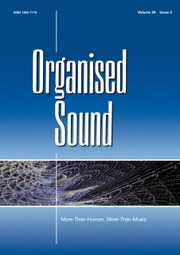Article contents
Improvisation through Performance-installation
Published online by Cambridge University Press: 14 February 2022
Abstract
This article builds on Richards’s work to formulate an understanding of the emerging practice of performance-installation, which embraces sound art, DIY electronic music and maker culture. A number of key points are addressed in this formulation: making/unmaking and ‘public making’; the assembling/disassembling of sonic devices and artefacts in the performance space; sound ‘through’ materials and materials at hand; and site and architectural features as material. In addition, readymade actions, illustrated by George Brecht’s The Cabinet, and the relationship between audience and performer are also presented. The article continues by outlining practice undertaken by the authors comprising two UK tours: ‘Sacrificial Floors’, 2018 with Tetsuya Umeda; and ‘Points of Failure’, 2020. Derek Bailey’s idea of ‘instrumental impulse’ is extended to include the concepts of expanded and reduced instruments that encompass ‘instrument as object’ and ‘raw material as instrument’. ‘Instrument’ is also viewed as a distributed mesh-like structure in which collective improvisation may occur. Borrowing from Ingold, ‘wayfaring’ is used to describe improvising with materials found ‘along the way’. Silent actions, uncontrollable instruments, unstable systems, performative failures, reimagined affordance of objects, ‘playing with resource’ and ‘improvising inside electronics’ are all addressed in relation to performance-installation. Finally, the authors explore the idea of ‘virtuosity in listening’, and question sonic autonomy and self-expression in improvisation and how ‘attending to sound’ can be an active part of improvised performance.
- Type
- Article
- Information
- Organised Sound , Volume 27 , Issue 2: The Sonic and the Electronic in Improvisation, Part 2 , August 2022 , pp. 144 - 155
- Copyright
- © The Author(s), 2022. Published by Cambridge University Press
References
- 1
- Cited by



